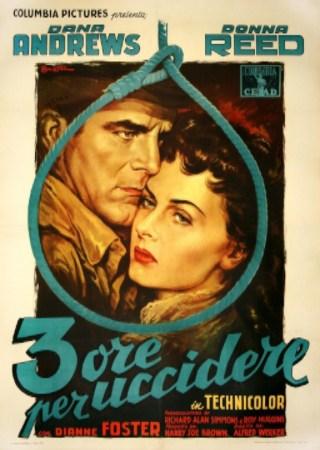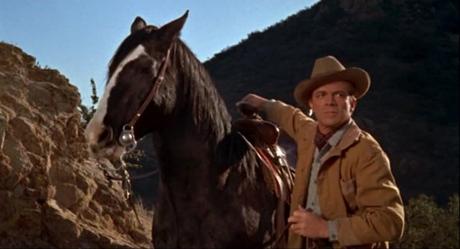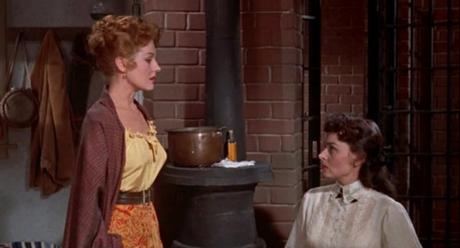
The last few posts on this site have seen the subsequent discussions spin off in various directions, taking in the idea of the auteur in cinema, the use of sets vs location shooting, and also touching on the pluses and minuses of the studio system. Today I want to take a look at Three Hours to Kill (1954), a movie whose director is not likely to be described as an auteur yet one whose work is of interest and displays some distinct characteristics, and it's also a good example of the kind of bread and butter material the studio system seemed to knock out effortlessly. It's a sparse and effective piece of work with no flab whatsoever, pared down and streamlined entertainment made by accomplished professionals.
The opening, to the accompaniment of Paul Sawtell's melancholic score, sees Jim Guthrie (Dana Andrews) heading back to his home town, heading back to see some of his old friends again. However much Guthrie might be looking forward to this reunion, it doesn't appear to be bringing him any happiness, and his friends are even less thrilled when he turns up. The thing is Guthrie's friends, as we discover via a short flashback sequence, tried to kill him three years before. To a man they were prepared to believe the worst of him and see him lynched for a murder he had no hand in. With friends like that, who needs enemies! So, what would bring a man back to such a place? That he survived at all, staying one step ahead of the law and just barely eluding capture, is largely down to his grit and determination. What sustained him as a fugitive those three years was his desire for justice and revenge, his hopes of making his tormentors feel the same slow, sliding dread he once did. Guthrie finds he has few allies left, the woman he once loved (Donna Reed) has married one of his former rivals, and mixed in with the dangers there are secrets beginning to stir in the shadows. The local sheriff (Stephen Elliott) has some sympathy but not much, in fact it amounts to only three hours' worth: three hours in which to find the man who framed him on a murder charge, and helped tear his life to pieces. What Guthrie finds out, about others and about himself, has the potential to bring damnation or salvation, depending on which fork of his conscience he decides to follow.

One of the first things you notice about Three Hours to Kill is how packed the script is and how tight the writers keep things as a consequence. The story comes from Alex Gottlieb with the script coming via Richard Alan Simmons and Roy Huggins, and some dialogue credited to Maxwell Shane. The plot is based on a combination of revenge tale and whodunit, Guthrie's quest for justice is conflated with a desire to avenge himself on his former friends, and even he seems unsure where the one ends and the other begins. In a film that runs just over an hour and a quarter that ought to be enough to be getting on with, but Three Hours to Kill offers even more. Underpinning all of this is the complex series of relationships between the protagonists, where jealousy, betrayals and moralizing all play a part in determining how everyone behaves. Even on the periphery of the main events and characters there are quite startling (considering the time the film was made) developments - there's the frank admission that one of the subsidiary characters is overtly engaged in what can only be described as a threesome, for example. Situations which might have provided the dramatic basis for a number of different movies are simply laid before the audience without any exposition or even analysis - they just are, and the viewer is expected to be sufficiently mature to appreciate that such things are part of life.
The writing is of course important under these circumstances, but it's also imperative that a confident and well-organized director is on hand. Alfred Werker, who was in charge of the similarly trim and compact The Last Posse, was the kind of man needed to ensure everything stayed focused and on course. Furthermore, it was a boon for Werker to have a talented cameraman like Charles Lawton working alongside him, ensuring his setups looked as good as possible.

A film like this, where the lead is scarred both externally and internally, whose demons are a short step away from fully consuming him, needed a man with a strong fatalistic sensibility. Who better under these circumstances than Dana Andrews, that veteran of so many westerns and films noir. The structure of the movie, with that flashback sequence, lets Andrews explore the change that comes over Guthrie (something which can be applied to a greater or lesser extent to other cast members too) and the contrast on view is a nice showcase for the kind of barely controlled emotional turmoil he was so adept at handling.
Aside from Andrews, the other big name in the cast is Donna Reed. She appeared in a handful of goodish westerns around this time as well as prestige productions like her Oscar-winning role in Zinnemann's From Here to Eternity. Her part as Andrews' old flame gave her some depth to work with, and so there was more to it than the kind of one-dimensional fare sometimes handed to actresses in programmer westerns of this type. Dianne Foster was the other woman in the cast with a significant role and spars well with Reed for the attentions of Andrews. Carolyn Jones was generally good value or better and was both touching and amusing as one side of a triangle involving Charlotte Fletcher and Laurence Hugo. Stephen Elliott and Richard Coogan are among the "friends" who would rather not renew their acquaintance with fugitive but the more memorable work is done by the seemingly ubiquitous Whit Bissell and James Westerfield.
Three Hours to Kill was a Columbia picture, produced by Harry Joe Brown, and has been released in the US by Sony as part of its MOD program. The film is also available in Europe, in both Spain and Italy. The Spanish disc I have presents the film 16:9 and looks reasonably good. There is a bit of softness but the colors look true and the print used doesn't appear to be damaged. The soundtrack plays in the original English and there are the usual optional Spanish subs that can be disabled. I enjoy this kind of solid lower budget affair, a type of film that is actually enormously satisfying if done properly. There's an impressive roster of talent on both sides of the camera and that helps to make Three Hours to Kill a modest but successful piece of filmmaking.
